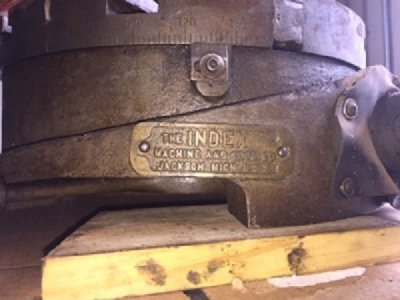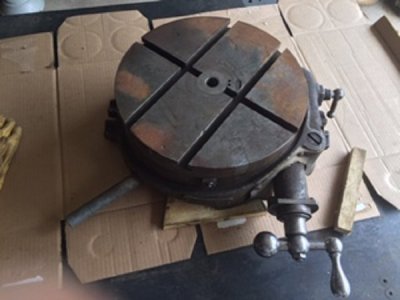-
Welcome back Guest! Did you know you can mentor other members here at H-M? If not, please check out our Relaunch of Hobby Machinist Mentoring Program!
You are using an out of date browser. It may not display this or other websites correctly.
You should upgrade or use an alternative browser.
You should upgrade or use an alternative browser.
What to look for in a used rotary table?
- Thread starter nnam
- Start date
I have to ask how big is your Mill? That has a great deal to do with the size you get. The table has to be large enough to hold the work while still allowing enough room for your tooling.
Mine is same model as this:

Coburn Precision 500 Horizontal Mill
I was browsing around a local used machine dealer and bumped into a Coburn Precision 500 horizontal milling machine. I've never heard of the company or the mill before but its a nice hobby sized horizontal mill and it comes with a vertical head attachment. The dealer mentioned it may be missing...
 www.hobby-machinist.com
www.hobby-machinist.com
and this:
A M Metalmaq Inc
inv.ammetalmaq.com
But I don't have vertical attachment. So I am doing the horizontal face mill with the NMTB #40.
It's very inconvenient and I hope to get or make a vertical head somehow.
I was asking about this since I followed the divider head thread, then I was thinking what if I am keeping an eye on used local stuff, and may get a decent deal. That's why I am getting the info for now.
- Joined
- Dec 20, 2012
- Messages
- 9,422
Okay, the knee has only 8" of vertical travel, which is not a lot. Keep in mind that the diameter of the rotary table is also tied to its vertical dimensions ... in general, the larger the diameter, the taller the height. You also need to account for the work holding method you need or plan to use. If you choose a vise or jawed chuck, just the size of that work holding device, when placed atop the rotary table, may make doing practical work near impossible.
My suggestion is to find the dimensions of whatever rotary table catches your eye and build a cardboard mock up of it to place on your mill to make sure you have enough room to use it. I did that on my RF-31, which has 14" of vertical travel and I chose to buy a 6" rotary table. An 8" would have fit but if I also put a 2 or 3" screwless vise on top of that and then tried to use an ER-chuck to hold an end mill, I would have had a difficult time machining a lot of my projects. A simple 3 jaw chuck would have been even worse.
Good luck!
My suggestion is to find the dimensions of whatever rotary table catches your eye and build a cardboard mock up of it to place on your mill to make sure you have enough room to use it. I did that on my RF-31, which has 14" of vertical travel and I chose to buy a 6" rotary table. An 8" would have fit but if I also put a 2 or 3" screwless vise on top of that and then tried to use an ER-chuck to hold an end mill, I would have had a difficult time machining a lot of my projects. A simple 3 jaw chuck would have been even worse.
Good luck!
That's a wonderful way of looking at it. I never thought about that. So this is a no go for me for now. Maybe when I buy a vertical mill or something bigger than this.Okay, the knee has only 8" of vertical travel, which is not a lot. Keep in mind that the diameter of the rotary table is also tied to its vertical dimensions ... in general, the larger the diameter, the taller the height. You also need to account for the work holding method you need or plan to use. If you choose a vise or jawed chuck, just the size of that work holding device, when placed atop the rotary table, may make doing practical work near impossible.
My suggestion is to find the dimensions of whatever rotary table catches your eye and build a cardboard mock up of it to place on your mill to make sure you have enough room to use it. I did that on my RF-31, which has 14" of vertical travel and I chose to buy a 6" rotary table. An 8" would have fit but if I also put a 2 or 3" screwless vise on top of that and then tried to use an ER-chuck to hold an end mill, I would have had a difficult time machining a lot of my projects. A simple 3 jaw chuck would have been even worse.
Good luck!
- Joined
- Dec 20, 2012
- Messages
- 9,422
Quite often, a rotary table is purchased because we envision needing it in the future, only to find that it often sits unused for long periods of time. Not a great way to store your money. Best to buy one when you really need it and not before.
- Joined
- Apr 14, 2014
- Messages
- 3,164
In my previous post on this subject I mentioned I was looking for a 12" to 15" rotary table for some larger work. Yesterday I was able to purchase a 12" Index brand table for a reasonable cost. This is a little older table in that it's labeled "Index Tool & Machine Works" rather than Wells-Index. The next steps are to clean it up and possibly grind the top to remove some past indiscretions.




- Joined
- Jan 23, 2013
- Messages
- 107
I have a bridgeport j head machine would not go any bigger than 10" would definetly want both horizontal and verticalWhat are the size ranges that would be ok general purpose homeshop use?
What else besides the usual wear, tear, slack and precision?
- Joined
- Jun 22, 2016
- Messages
- 280
I recently bought an 8" RT, tail stock, index plates & a 3 jaw chuck. I have a 9x49 Jet that is a Bridgeport knock off. Turns out I can't really use the chuck on the RT due to not enough Z-axis. Clamping things directly to the RT works but even the strap clamps add Ht. They also take up table space greatly reducing the available area for the work. I've decided to make a pallet for the RT to add size and methods of clamping. The Vertex table only has 3 slots that also limits your clamping choices. Now I'm seriously considering a riser for the mill. That also means a power drawbar. One thing leads to another.
By the time you put a drill chuck in the spindle + 4" of RT + even a screw bit it doesn't leave much for the work.
As for the wt. an 8" table weighs about 55#s adding a chuck makes it heavier than I feel comfortable lifting.
By the time you put a drill chuck in the spindle + 4" of RT + even a screw bit it doesn't leave much for the work.
As for the wt. an 8" table weighs about 55#s adding a chuck makes it heavier than I feel comfortable lifting.
- Joined
- Apr 14, 2014
- Messages
- 3,164
I guess I'm not understanding the height problem with rotary tables. My 8" table with both X and Y axis movements stands only 5 3/8" tall. The "new" 12"(no X & Y movements) one is only 5" tall. My Palmgren 8" vise is 6" tall and my 6" Bridgeport vise with the swivel base is 7" tall. I've yet to need to mill anything I couldn't fit under the quill.
Both my rotary tables are horizontals only. If I nee to something on a vertical axis I clamp them to an angle plate
Both my rotary tables are horizontals only. If I nee to something on a vertical axis I clamp them to an angle plate
- Joined
- Jun 22, 2016
- Messages
- 280
Depends on the size of the parts. Spindle nose to table max 17.5". RT thickness 4". For milling Length of tool 3" + 3/4" strap clamp Leaves 9.75 for max work. But now mount a drill chuck leaves 6.25" but wait I want to use a boring head even less work space left. Then I decide I'd like to use the 8" chuck so I can rapidly swap out parts, 4.75", I'm down to 2.25" that can be sticking out of the chuck.
I work on quite a few castings. Besides being bulky they are often awkward to mount.
You're right though, for much of what us hobby types machine there is probable plenty of room. I got started on this because I had recently mounted a casting that had been repaired (brazed) and needed to be re-bored and have an O ring groove machined. It just barely fit on my mill.
I work on quite a few castings. Besides being bulky they are often awkward to mount.
You're right though, for much of what us hobby types machine there is probable plenty of room. I got started on this because I had recently mounted a casting that had been repaired (brazed) and needed to be re-bored and have an O ring groove machined. It just barely fit on my mill.

